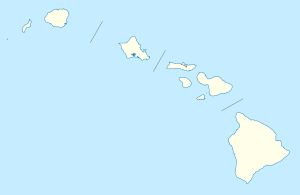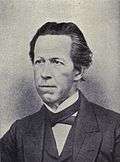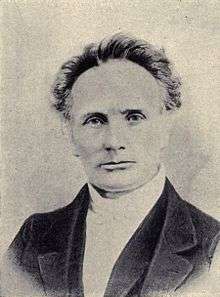Kahikolu Church
|
Kahikolu Church | |
|
The restored church in use today | |
 | |
| Nearest city | Napoʻopoʻo, Hawaii |
|---|---|
| Coordinates | 19°28′10″N 155°54′55″W / 19.46944°N 155.91528°WCoordinates: 19°28′10″N 155°54′55″W / 19.46944°N 155.91528°W |
| Area | 2.6 acres (1.1 ha) |
| Built | 1855 |
| Architect | John D. Paris |
| NRHP Reference # | 82000148[1] |
| Added to NRHP | November 15, 1982 |
Kahikolu Church is one of only two stone churches from the 19th century on the island of Hawaii. It was built from 1852–1855 on the site of an earlier building known as Kealakekua Church that was built around 1833 in the Kona district.
History
English missionary William Ellis (1794–1872) toured the island in the summer of 1823 to determine locations for mission stations and suggested the village of Kaʻawaloa at the north end of Kealakekua Bay as one of the first sites for a church.[2]:19



In February 1824 High Chiefess Kapiʻolani built a thatched house in the village of Kaʻawaloa for use as a Christian church by Rev. James Ely (1798–1890) and his family. Ely left Kaʻawaloa in 1828, replaced by Rev. Samuel Ruggles (1795–1871), who brought some coffee trees with him from the Hilo mission.[3] Ruggles was replaced due to ill health in June 1833 by Rev. Cochran Forbes (1805–1880). Forbes built a house at a cooler elevation, at a site called Kuapehu which had been used to grow taro.[4] In 1839, under the direction of Kapiʻolani, Forbes moved the mission to the south side of Kealakekua Bay, in an area called Kepulu, just inland from the village now called Nāpoʻopoʻo.[5] Another house was built here, and a church which was 120 feet (37 m) by 57 feet (17 m) of stone and coral lime. In 1841 the Kealakekua Church was finished, and used until June 1845, when Forbes resigned because of his wife's ill health.[6]
After six years with no pastor, Rev. John Davis Paris (1809–1892) arrived in 1852. His family had been at Waiʻōhinu for several years, returned to the United States, and then came back to the island and were posted to the Kealakekua congregation. He found the large old church in ruins. He set about building a more solid but smaller stone church called Kahikolu on the site of the old one. Kahikolu means "three in one" in the Hawaiian language, which refers both to the Holy Trinity of the Christian faith, but also that it was the third attempt to build a church here. The width of the old church became the length of the new one, resulting in a building about 57 feet (17 m) by 62 feet (19 m), with walls 35 inches (89 cm) thick.[7]
Kahikolu took three years to build, and included a bell donated by William E. Dodge of New York. It could hold a total of about 1200 people. Paris went on to build eight more churches (including Hale Halawai O Holualoa), and died in the area in 1892.[8] There are grave sites located on both sides of the church, some of which are unmarked.[9] Several bear the name of "Kamakau", probably descendants of a chief Kelou Kamakau, born about 1773 who was mentioned in Ellis' journal as a good source of history.[2]
Decline and restoration
In 1925 a layer of plaster was added to the inside walls, and the ceiling and floor replaced. In 1929, an earthquake caused one of the gable ends to tumble into the church. They were replaced with horizontal wood strips. Once the largest church on the west side of the island, its influence declined as population moved to other areas.[7] On August 21, 1951, an earthquake with magnitude 6.9 was centered almost under the church.[10] The roof collapsed after more earthquakes in 1952 and 1953. The stone church was abandoned in 1953 due to the damage.[7]
Kahikolu church was added to the National Register of Historic Places listings on the island of Hawaii on November 15, 1982 as site 82000148, and the state list as site 10-47-7215 on July 30, 1982.[11] The only other stone church from this era on the island is Mokuaikaua Church, about 12 miles (19 km) to the north. P A rebuilding effort lasted through the 1980s. Kahikolu Church restoration was completed around 1984. On July 13, 1993 the Hawaiian who inspired the first missionaries, Henry ʻŌpūkahaʻia, known as Henry Obookiah during his lifetime (c. 1792–1818), was re-interred in the Kahikolu cemetery, at the request of his descendants.[12] The church was finally restored and opened again for use in 1999. A historical marker was added in 2003.[13]
The address of the congregation is 82-6013 Puʻuhonua Road, Captain Cook, coordinates 19°28′10″N 155°54′55″W / 19.46944°N 155.91528°W. Sunday services are held at 9:30 AM with Sunday School at 8:30. The pastor (as of July 2011) is Wendell Davis.[14] In November 2003, under the urging of pastor Davis, Kahikolu Congregational Church voted to disaffiliate from the United Church of Christ because of the UCC "open and affirming" ordination of practising gay and lesbian pastors.[15] The members were considering leaving the UCC but have not actually done so as of 2013.
The variety of coffee Ruggles brought in 1828 thrived in the part of the island around Kealakekua, called the Kona District. Because it was the first coffee grown on the western side of the island, it is often referred to as the first Kona coffee, still popular today.[3][16][17]
See also
References
- ↑ National Park Service (2009-03-13). "National Register Information System". National Register of Historic Places. National Park Service.
- 1 2 William Ellis (1823). "A journal of a tour around Hawai'i, the largest of the Sandwich Islands". Crocker and Brewster, New York, republished 2004, Mutual Publishing, Honolulu. ISBN 1-56647-605-4.
- 1 2 Thomas G. Thrum (1891). "History of Coffee in Hawaii". All about Hawaii. Honolulu Star-Bulletin. pp. 63–68.
- ↑ Lloyd J. Soehren. "lookup of Kuapehu". Place name of Hawaii. University of Hawaii. Retrieved 2009-10-20.
- ↑ Lloyd J. Soehren. "lookup of Kepulu". Place name of Hawaii. University of Hawaii. Retrieved 2009-10-20.
- ↑ "Cochran Forbes", Necrological reports and annual proceedings of the Alumni association, 1, Princeton Theological seminary, 1891, p. 34
- 1 2 3 Lois M. Humphrey, Kahikolu Restoration Committee (May 26, 1982). "Kahikolu Church nomination form" (PDF). National Register of Historic Places. National Park Service. Retrieved 2009-10-20.
- ↑ William Paris. "John D. Paris". Conference Legacy Stories. Hawaii Conference of the United Church of Christ. Retrieved 2009-10-12.
- ↑ Geoff Stafford (June 14, 2002). "Kahikolu Congregational Cemetery". Genweb.org. Retrieved 2009-10-20.
- ↑ "Historic Earthquakes: Near Napoopoo, Hawaii, 1951 August 21 UTC, Magnitude 6.9". U.S. Geological Survey. Retrieved 2009-10-20.
- ↑ "Historic Places in Hawaii County" (PDF). official state web site. Retrieved 2009-10-12.
- ↑ "House Resolution 52". State of Hawaii House of Representatives. 2008. Retrieved 2009-10-12.
- ↑ Rod Thompson (July 21, 2003). "Missionary's grave to get historical ornament". Honolulu Star-Bulletin.
- ↑ "Kahikolu Congregational Church". Hawaii Conference of the United Church of Christ. Retrieved 2009-10-12.
- ↑ Timothy Totten, Kahikolu.Org web site, retrieved 2009-10-20
- ↑ Kona Historical Society (1997). A Guide to Old Kona. University of Hawaii Press. p. 6. ISBN 978-0-8248-2010-7.
- ↑ Gerald Kinro (2003). A cup of aloha: the Kona coffee epic. University of Hawaii Press. p. 123. ISBN 978-0-8248-2678-9.
Further reading
John Davis Paris (1926). Mary Card Porter, Ethel Moseley Damon, eds. Fragments of real missionary life: from the recollections of The Rev. John D. Paris. The Friend.
